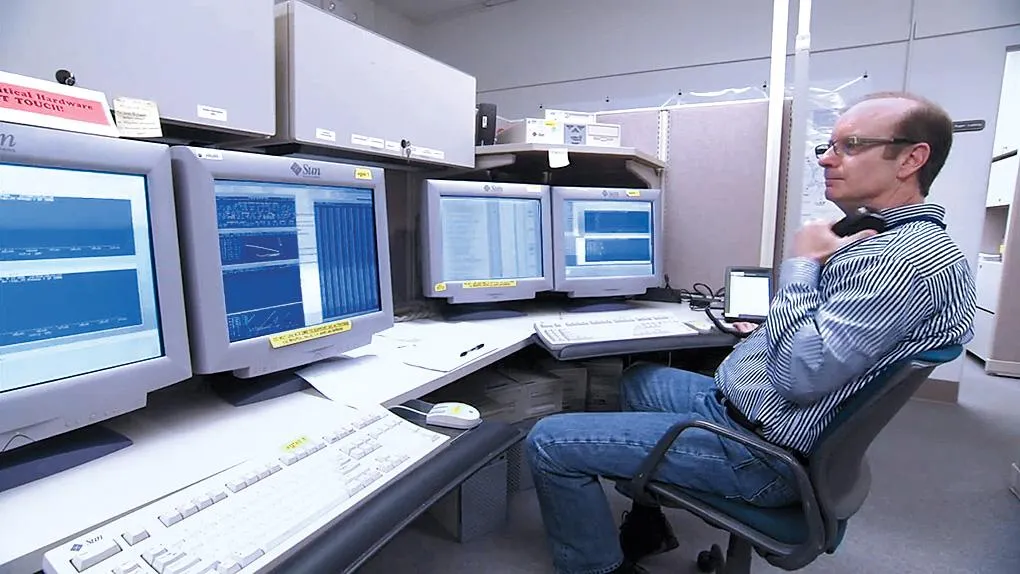Voyager, Still Going After All These Years
Low on power and billions of miles from Earth, NASA’s twin spacecraft keep exploring—with a little TLC from home.
/https://tf-cmsv2-smithsonianmag-media.s3.amazonaws.com/filer/23/dd/23dd87ad-7ad2-4d4b-9cb7-5f174079de6f/voyager_still.jpg)
The twin Voyager spacecraft, NASA’s oldest, most venerable explorers, are still continuously transmitting data back to Earth. Launched in 1977 to study the large outer planets, Voyager 1 and 2 are now, respectively, more than 13 billion and 11 billion miles from Earth, exploring the outer boundary of the heliosphere—a vast magnetic sphere created by the sun that surrounds the solar system. The 42-year-old spacecraft also present immense challenges to those responsible for their care.
The data stream from the Voyagers is continuous at a rate of 160 bits per second. (The one exception is that Voyager 1 has the ability to record data from the Plasma Wave Subsystem and transmit it at designated times.) NASA captures the data when one of the antennas in its Deep Space Network is pointed at the spacecraft, about six hours per day for each probe. The data is then transferred from the antenna site to JPL’s central mission control, and then to the project mission support office, which processes the data and makes it available to the science teams.
That data also allows JPL engineers to regularly monitor the spacecrafts’ vital signs. Seeing the health or weakness of the instruments, the engineers improvise creative fixes, working with equipment built for planetary exploration that must now adapt to the needs of an interstellar mission. “It’s repurposing systems to do things they were not designed to do, but can do,” says Dodd.
For instance, the magnetometer (MAG), which was originally designed to measure the magnetic fields of Jupiter, Saturn, Uranus, and Neptune, is now studying the interaction of the magnetic field of the sun with the magnetic field of interstellar space—and is a crucial instrument for researchers who want to learn more about the shape of the heliosphere. The MAG, though, was designed for planetary magnetic fields, which are much stronger than interstellar ones. “So it takes a lot of analysis and a lot of review to pull a weak signal out of the noise of the instrument,” says Dodd.

In addition to powering the instruments, the generators keep the heaters running. Without heat, the temperature aboard the Voyagers would plummet. While some instruments can function at the subzero temperatures in deep space, the freezing point of the spacecrafts’ propellant is around 34.5 degrees Fahrenheit. If the propellant lines freeze, engineers would no longer be able to use the probes’ thrusters to keep their antennas oriented toward Earth to transmit data. “So for about the last five years, it’s actually been a balance between power and thermal,” says Dodd.
Maintaining that balance plays out differently for each instrument. For instance, Voyagers’ cameras, the Imaging Science Subsystem, were the first to be shut down. Designed to take photos of the outer planets, “there wasn’t any more science you could get out of that instrument,” says Dodd, “and there’s a certain amount of memory space that was freed up that we could then repurpose for this longer Voyager interstellar mission.”
But sometimes the location of an instrument surpasses other concerns. For instance, there’s a digital tape recorder still running on Voyager 1 that would reduce power consumption if it were turned off, says Dodd. Instead, NASA keeps it on because the instrument generates some heat in a particular area of the probe’s central bus that helps keep the propellant lines warm.
Other instruments, such as the Cosmic Ray Subsystem (CRS)—which detects super-energetic particles—sit out on a boom away from the bus and have their own heating units. NASA shut down the CRS’ heater on Voyager 2 this past summer. Despite the extreme cold (minus 76 degrees Fahrenheit), the instrument is still functioning. “We gained two things by turning [the heater] off,” says Dodd. “We gained power...and that extra power also provided extra heat in the bus because it’s not going out to the boom now.”
With the CRS still running, scientists continue to gain valuable data. Cosmic rays are a type of high-energy particles: fragments of atoms created by supernovae outside the solar system and accelerated to nearly the speed of light that bombard Earth from all directions. “The heliosphere is a shield against all those cosmic rays that have speeds less than about 50 percent the speed of light,” says Ed Stone, who has served as project scientist for the Voyager program since 1972.

Despite its success in keeping the Voyagers going, NASA has reached the point where it is one anomaly away from losing the spacecraft. JPL engineers were very concerned when they discovered that the primary attitude thrusters on both spacecraft had degraded. “The way a thruster shows age is it starts to pulse many more times to get the same amount of thrust,” says Dodd. To keep the Voyagers oriented toward Earth to transmit data, the JPL engineers have instead fired up another set of thrusters that were used for trajectory correction maneuvers and haven’t been used since the planetary flybys early in the mission.
“I always tell people, my personal goal is to have a spacecraft that celebrates its 50th anniversary from launch,” says Dodd. With more than a little luck, the Voyagers might make it.
/https://tf-cmsv2-smithsonianmag-media.s3.amazonaws.com/filer/75/e6/75e6143c-29ee-4ecc-bbc7-a45fa6fcec22/screen_shot_2019-11-18_at_50833_pm.png)
/https://tf-cmsv2-smithsonianmag-media.s3.amazonaws.com/accounts/headshot/mark-strauss-240.jpg)

/https://tf-cmsv2-smithsonianmag-media.s3.amazonaws.com/accounts/headshot/mark-strauss-240.jpg)